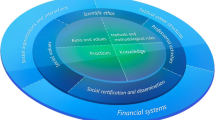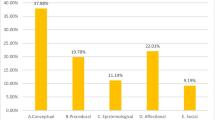Abstract
This paper investigated the change of the Junior Secondary School Chemistry Curriculum (JSSCC) in the P. R. China over the period from 1978 to 2001. Document analysis was employed as the research method and data were collected from various versions of teaching syllabi, textbooks, and teachers' reference books published during this period. The changes of the purposes and content of the JSSCC were traced in the view of scientific literacy, which incorporates both subject matter and companion meanings in the light of the concept of ‘curriculum emphases.’ It was found that subject matter had been increasingly enlarged in its breadth but its requirements gradually decreased while companion meanings at different levels of this curriculum had been increasingly added from 1978 to 2001. On the basis of these findings it was concluded that the JSSCC had experienced a transition from being more elite to more future citizenry oriented during the period under study. Two implications of this study for science curriculum research were discussed.
Similar content being viewed by others
References
Akker, J. V. (1998). The science curriculum: Between ideas and outcomes. In B. J. Fraser & K. J. Tobin (Eds.), International handbook of science education (pp. 421–447). Kluwer.
American Association for the Advancement of Science (AAAS) (1989). Science for all Americans: A project 2061 report on goals in science, mathematics, and technology. Washington, DC: Author.
Atkin, J. M. (1998). The OECD study of innovation in science, mathematics and technology education. Journal of Curriculum Studies, 30(6), 647–660.
Bell, J. (1999). Doing your research project: A guide for first-time researchers in education and social science (3rd edition). Philadelphia: Open University Press.
Brickhouse, N. W., Ebert-May, D., & Wier, B. A. (1989). Scientific literacy: Perspectives of school administrators, teachers, students, and scientists from an urban mid-Atlantic community. In A. B. Champagne & B. E. (Eds.), This year in school science 1989: Scientific literacy (pp. 157–176). Washington, DC: AAAS.
Bybee, R. W. (1997). Toward an understanding of scientific literacy. In W. Graber & C. Bolte (Eds.), Scientific literacy (pp. 37–68). Kiel, FRG: IPN.
Bybee, R. W., & Ben-Zvi, N. (1998). Science curriculum: Transforming goals to practices. In B. J. Fraser & K. J. Tobin (Eds.), International handbook of science education (pp. 487–498). London: Kluwer.
Bybee, R. W., & DeBoer, G. E. (1994). Research on goals for the science curriculum. In D. L. Gabel (Ed.), Handbook of research on science teaching (pp. 357–387). New York: Macmillan.
Chemistry Editorial Board (1981). An outline of the chemistry textbook of junior secondary schools in full-time and five-year secondary schools and full-time and six-year key secondary schools. Huaxue Jiaoyu, (5), 37–40 (in Chinese).
Chiappetta, E. L., Sethna, G. H., & Fillman, D. A. (1991). A quantitative analysis of high school chemistry textbooks from scientific literacy themes and expository learning aids. Journal of Research in Science Teaching, 28(10), 939–951.
Fensham, P. (1992). Science and technology. In P. W. Jackson (Ed.), Handbook of research on curriculum (pp. 789–829). New York: Macmillan.
Fensham, J. P. (1997) School science and its problems with scientific literacy. In R. Levinson & J. Thomas (Eds.), Science today: Problem or crisis (pp. 119–136). London: Routledge.
Jenkins, E. (1994) History of science education. In T. Husen & T. N. Postlethwaite (Eds.), The international encyclopedia of education (2nd edition) (pp. 5324–5328). Oxford, UK: Pergamon.
Laugksch, R. C. (2000). Scientific literacy: A conceptual overview. Science Education, 84(1), 71–94.
Ministry of Education (1978). The chemistry syllabus of secondary schools of full-time and ten-year system (trial draft). Beijing, PRC: People's Education (in Chinese).
Ministry of Education (2001). The chemistry curriculum standard of compulsory education of full-time system. Beijing, PRC: Beijing Normal University Press (in Chinese).
National Research Council (NRC). (1996). National science education standards. Washington, District of Columbia: Author.
People Education Press (PEP) (1978). Chemistry: A textbook of junior secondary schools of full-time and ten-year school system. Beijing, PRC: People's Education (in Chinese).
People Education Press (PEP) (1982a). Chemistry: A textbook of junior secondary schools. Beijing, PRC: People's Education (in Chinese).
People Education Press (PEP) (1982b). Teachers' reference to chemistry of junior secondary schools. Beijing, PRC: People's Education (in Chinese).
People Education Press (PEP) (1995). Chemistry: A textbook of three-year junior secondary schools of nine-year compulsory education. Beijing, PRC: People's Education (in Chinese).
People Education Press (PEP) (2001b). Chemistry: A textbook of the curriculum standard of compulsory education (Book One). Beijing, PRC: People's Education (in Chinese).
People Education Press (PEP) (2001c). Chemistry: A textbook of the curriculum standard of compulsory education (Book Two). Beijing, PRC: People's Education (in Chinese).
Roberts, D. (1982) Developing the concept of curriculum emphasis in science education. Science Education, 66(2), 243–260.
Roberts, D. (1988) What counts as science education? In P. Fensham (Ed.), Development and dilemma in science education (pp. 27–55). Philadelphia: Falmer.
Roberts, D. (1995). Junior high school science transformed: Analyzing a science curriculum policy change. International Journal of Science Education, 17(4), 493–504.
Roberts, D. (1998). Analyzing school science courses. In D. Roberts & L. Ostman (Eds.), Problems of meanings in science curriculum. New York: Teachers College.
Robson, C. (2002). Real world research (2nd edition). Hong Kong: Blackwell.
State Education Commission (1992). The chemistry syllabus of junior secondary schools of nine-year compulsory education (trial version). Beijing, PRC: People's Education (in Chinese).
Wilkinson, J. (1999). A quantitative analysis of physics textbooks for science literacy themes. Research in Science Education, 29(3), 385–399.
Wu, L., Chen, H., & Lu, D. (1992). Theories and practices in making teaching materials of primary and secondary schools in new China. In The Chinese Association of International Education Exchange (Ed.), Curriculum development and social progress (pp. 15–22). Beijing, PRC: People's Education (in Chinese).
Author information
Authors and Affiliations
Corresponding author
Rights and permissions
About this article
Cite this article
Wei, B., Thomas, G.P. An Examination of the Change of the Junior Secondary School Chemistry Curriculum in the P. R. China: In the View of Scientific Literacy. Res Sci Educ 36, 403–418 (2006). https://doi.org/10.1007/s11165-006-9012-y
Received:
Accepted:
Published:
Issue Date:
DOI: https://doi.org/10.1007/s11165-006-9012-y




